National Search and Rescue Plan:
- The National Search and Rescue Plan provides effective use of all available facilities in all types of SAR missions
- Facilities include aircraft, vessels, pararescue and ground rescue teams, and emergency radio fixing
- The U.S. Coast Guard is responsible for coordination in Maritime Region
- The USAF is responsible in the Inland Region
- Rescue Coordination Centers (RCC) coordinate SAR efforts within their regions [Figures 1-4]
- Aircraft emergencies, distress, and urgency information is passed to the appropriate RCC through Air Route Traffic Control Centers (ARTCCs) or Flight Service Stations (FSS)
- Rescue Coordination Center Contacts:
- Air Force: 1–800–851–3051
- Alaska: 1–800–420–7230
- Coast Guard: 1–855–406–8724
Rescue Coordination Centers:
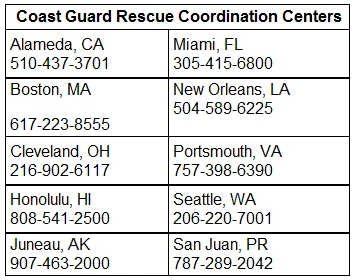
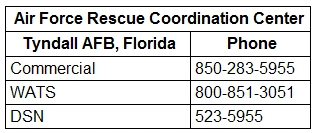
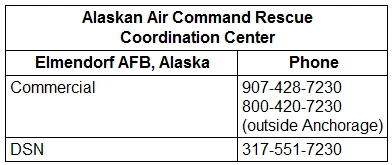
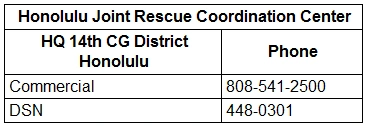
Emergency and Overdue Aircraft:
- ARTCCs and FSS' will alert the SAR system if an aircraft is in difficulty, overdue, or missing
- Radar facilities providing radar flight following or advisories consider the loss of radar and radios, without service termination notice, to be a possible emergency
- Pilots receiving VFR services from radar facilities should be aware that SAR may be initiated under these circumstances
- A filed flight plan is the most timely and effective indicator that an aircraft is overdue
- Flight plan information is invaluable to SAR forces for search planning and executing search efforts
- Radar facilities providing radar flight following or advisories consider the loss of radar and radios, without service termination notice, to be a possible emergency
- Prior to departure on every flight, local or otherwise, someone at the departure point should be advised of your destination and route of flight if other than direct
- Search efforts are often wasted and rescue is often delayed because of pilots who thoughtlessly takeoff without telling anyone where they are going. File a flight plan for your safety
- According to the National Search and Rescue Plan, "The life expectancy of an injured survivor decreases as much as 80 percent during the first 24 hours, while the chances of survival of uninjured survivors rapidly diminishes after the first 3 days"
- An Air Force Review of 325 SAR missions conducted during a 23-month period revealed that "Time works against people who experience a distress but are not on a flight plan, since 36 hours normally pass before family concern initiates an (alert)"
VFR Search and Rescue Protection:
- To receive this valuable protection, file a VFR or DVFR Flight Plan with an FAA FSS
- For maximum protection, file only to the point of first intended landing, and refile for each leg to final destination
- When a lengthy flight plan is filed, with several stops en route and an ETE to final destination, a mishap could occur on any leg, and unless other information is received, it is probable that no one would start looking for you until 30 minutes after your ETA at your final destination
- If you land at a location other than the intended destination, report the landing to the nearest FAA FSS and advise them of your original destination
- If you land en route and are delayed more than 30 minutes, report this information to the nearest FSS and give them your original destination
- If your ETE changes by 30 minutes or more, report a new ETA to the nearest FSS and give them your original destination
- Remember that if you fail to respond within one-half hour after your ETA at final destination, a search will be started to locate you
- It is important that you close your flight plan IMMEDIATELY AFTER ARRIVAL AT YOUR FINAL DESTINATION WITH THE FSS DESIGNATED WHEN YOUR FLIGHT PLAN WAS FILED
- The pilot is responsible for closure of a VFR or DVFR flight plan; they are not closed automatically
- This will prevent needless search efforts
- The rapidity of rescue on land or water will depend on how accurately your position may be determined
- If a flight plan has been followed and your position is on course, rescue will be expedited
- There are tools available to remind you to close your flight plan such as EasyActivate™ and EasyClose™
- Ensure activation of ELT, and if not already using, fly with a GPS enabled 406 MHz transmitter
Intercept and Escort:
- The concept of airborne intercept and escort is based on the Search and Rescue (SAR) aircraft establishing visual and/or electronic contact with an aircraft in difficulty, providing in-flight assistance, and escorting it to a safe landing. If bailout, crash landing or ditching becomes necessary, SAR operations can be conducted without delay. For most incidents, particularly those occurring at night and/or during instrument flight conditions, the availability of intercept and escort services will depend on the proximity of SAR units with suitable aircraft on alert for immediate dispatch. In limited circumstances, other aircraft flying in the vicinity of an aircraft in difficulty can provide these services
- If specifically requested by a pilot in difficulty or if a distress condition is declared, SAR coordinators will take steps to intercept and escort an aircraft. Steps may be initiated for intercept and escort if an urgency condition is declared and unusual circumstances make such action advisable
- It is the pilot's prerogative to refuse intercept and escort services. Escort services will normally be provided to the nearest adequate airport. Should the pilot receiving escort services continue onto another location after reaching a safe airport, or decide not to divert to the nearest safe airport, the escort aircraft is not obligated to continue and further escort is discretionary. The decision will depend on the circumstances of the individual incident
Survival Equipment:
- For flight over uninhabited land areas, it is wise to take and know how to use survival equipment for the type of climate and terrain
- If a forced landing occurs at sea, chances for survival are governed by the degree of crew proficiency in emergency procedures and by the availability and effectiveness of water survival equipment
Body Signals:
- If you are forced down and are able to attract the attention of the pilot of a rescue airplane, body signals can be used to transmit messages to a pilot circling over your location [Figure 5-7]
- Stand in the open when you make the signals
- Be sure the background, as seen from the air, is not confusing
- Go through the motions slowly and repeat each signal until you are positive that the pilot understands you
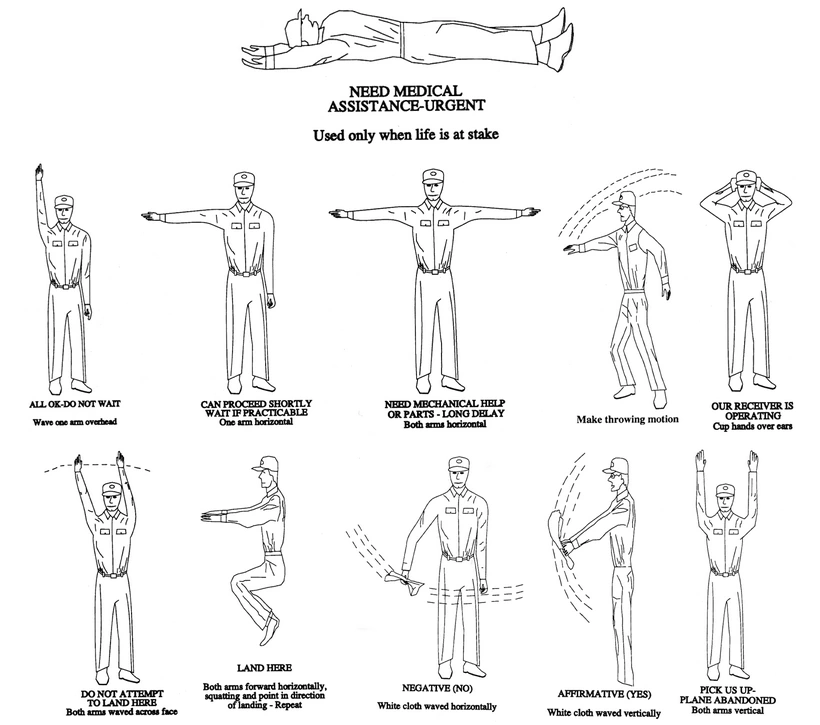
Observance of Downed Aircraft:
- Determine if crash is marked with a yellow cross; if so, the crash has already been reported and identified
- If possible, determine type and number of aircraft and whether there is evidence of survivors
- Fix the position of the crash as accurately as possible with reference to a navigational aid
- If possible, provide geographic or physical description of the area to aid ground search parties
- Transmit the information to the nearest FAA or other appropriate radio facility
- If circumstances permit, orbit the scene to guide in other assisting units until their arrival or until you are relieved by another aircraft
- Immediately after landing, make a complete report to the nearest FAA facility, or Air Force or Coast Guard Rescue Coordination Center
- The report can be made by a long distance collect telephone call


Aircraft Signals:
- Provide non-verbal communication in intercept or lost communication scenarios [Figure 8]
- Can also be used to acknowledge ground signals
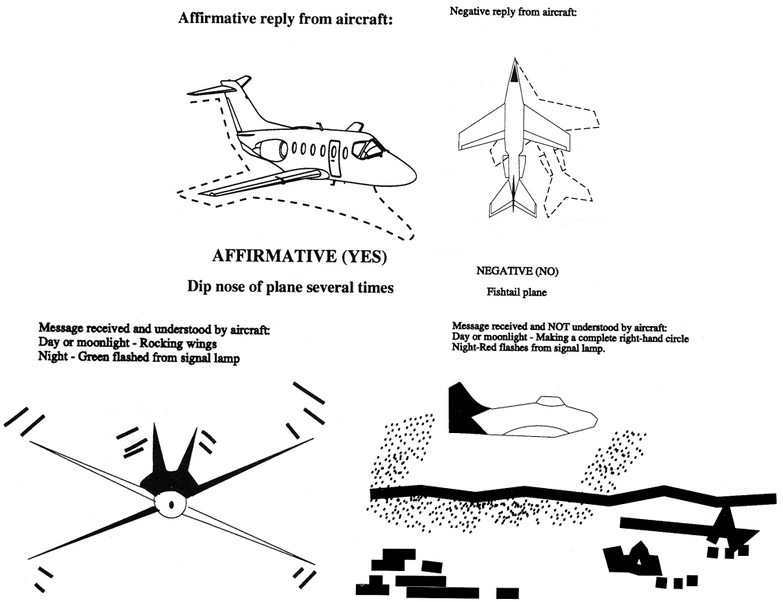
The flight expectancy of an injured survivor decreases as much as 80% during the first 24 hours, while the chances of survival of uninjured survivors rapidly diminishes after the first 3 days
Time works against people who experience a distress but are not on a flight plan, since 36 hours normally pass before family concern initiates an (alert)
Search and Rescue Case Studies:
- National Transportation Safety Board (NTSB) Identification: DFW08FA053:
- The NTSB determines the probable cause(s) of this accident to be: The pilot's decision to continue to the destination landing platform in weather conditions below the company's weather minimums and his failure to maintain aircraft control during the approach. Contributing to the passenger fatality and the severity of the occupant injuries were the lack of a passenger briefing on how to deploy the liferaft, which was required by the company but not by the Federal Aviation Administration because this flight was not an extended overwater operation; the pilot's failure to deploy the liferafts; and the company radio operator's misreporting of the helicopter's "landed" status, which delayed the rescue response
Conclusion:
- According to the National Search and Rescue Plan, "The life expectancy of an injured survivor decreases as much as 80% during the first 24 hours, while the chances of survival of uninjured survivors rapidly diminishes after the first 3 days"
- An Air Force Review of 325 SAR missions conducted during a 23-month period revealed that "Time works against people who experience a distress but are not on a flight plan, since 36 hours normally pass before family concern initiates an (alert)"
- Prior to departure on every flight, local or otherwise, someone at the departure point should be advised of your destination and route of flight if other than direct
- Search efforts are often wasted and rescue is often delayed because of pilots who thoughtlessly takeoff without telling anyone where they are going-File a flight plan for your safety!
- Services include search for missing aircraft, survival aid, rescue, and emergency medical help for the occupants after an accident site is located
- Search efforts are often wasted and rescue is often delayed because of pilots who thoughtlessly takeoff without telling anyone where they are going
- File a flight plan for your safety, and remember to close it!
- The first method for someone to observe a downed aircraft is through colorful paint schemes (aircraft painted green when ditched into forest are camoflaughed!)
- To avoid false alarms, pay close attention to ELT procedures when performing maintenance or tests
- The FAA investigates thousands of false ELT alerts every year, wasting resources
- If an ELT is accidentally activated, cancel the false alert by calling the U.S. Air Force Rescue Coordination Center
- Companies like McMurdo provide a state-of-the-art emergency response ecosystem, working in parallel with other agencies to aid effective search and rescue
- Still looking for something? Continue searching:
References:
- Federal Aviation Administration - Pilot/Controller Glossary
- Aeronautical Information Manual (6-2-3) Intercept and Escort
- Aeronautical Information Manual (6-2-6) Search and Rescue
- CFI Notebook.net Air Route Traffic Control Center (ARTCC)
- CFI Notebook.net - Ditching
- CFI Notebook.net - Emergency Equipment
- CFI Notebook.net - Emergency Transmitter Locator (ELT)
- CFI Notebook.net - VFR Flight Plan
- NYC Aviation - Inside the US Coast Guard's SAR Response to a Plane Crash
- Wikipedia - The National SAR Plan